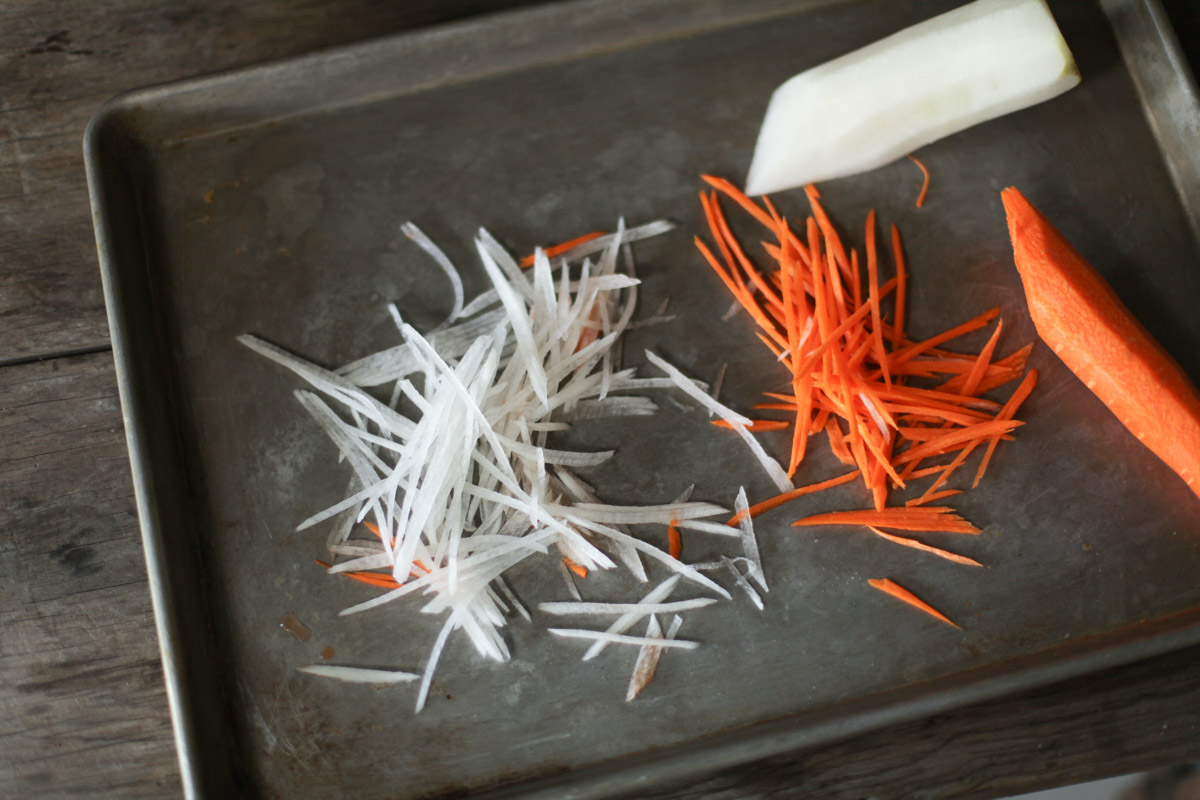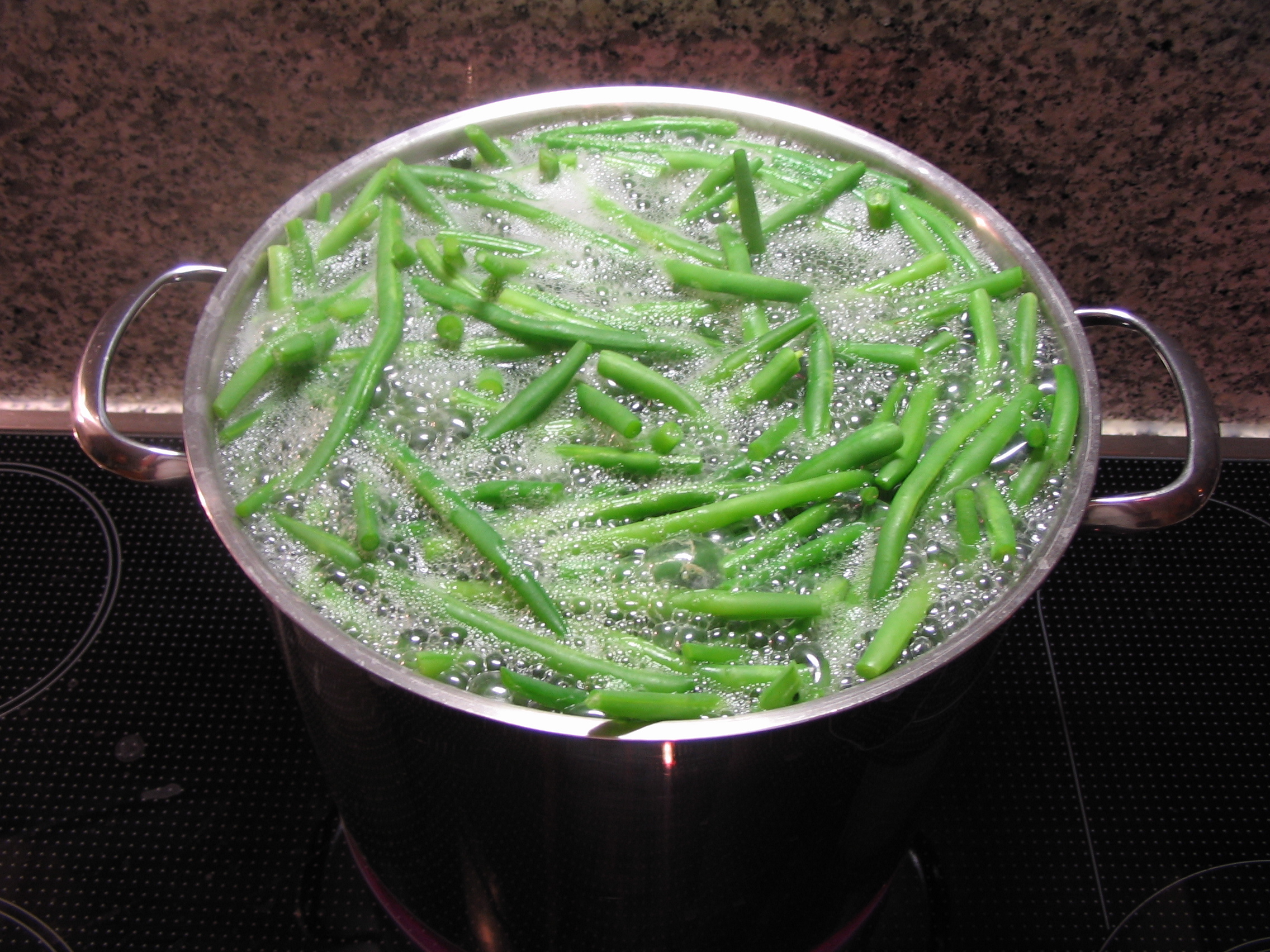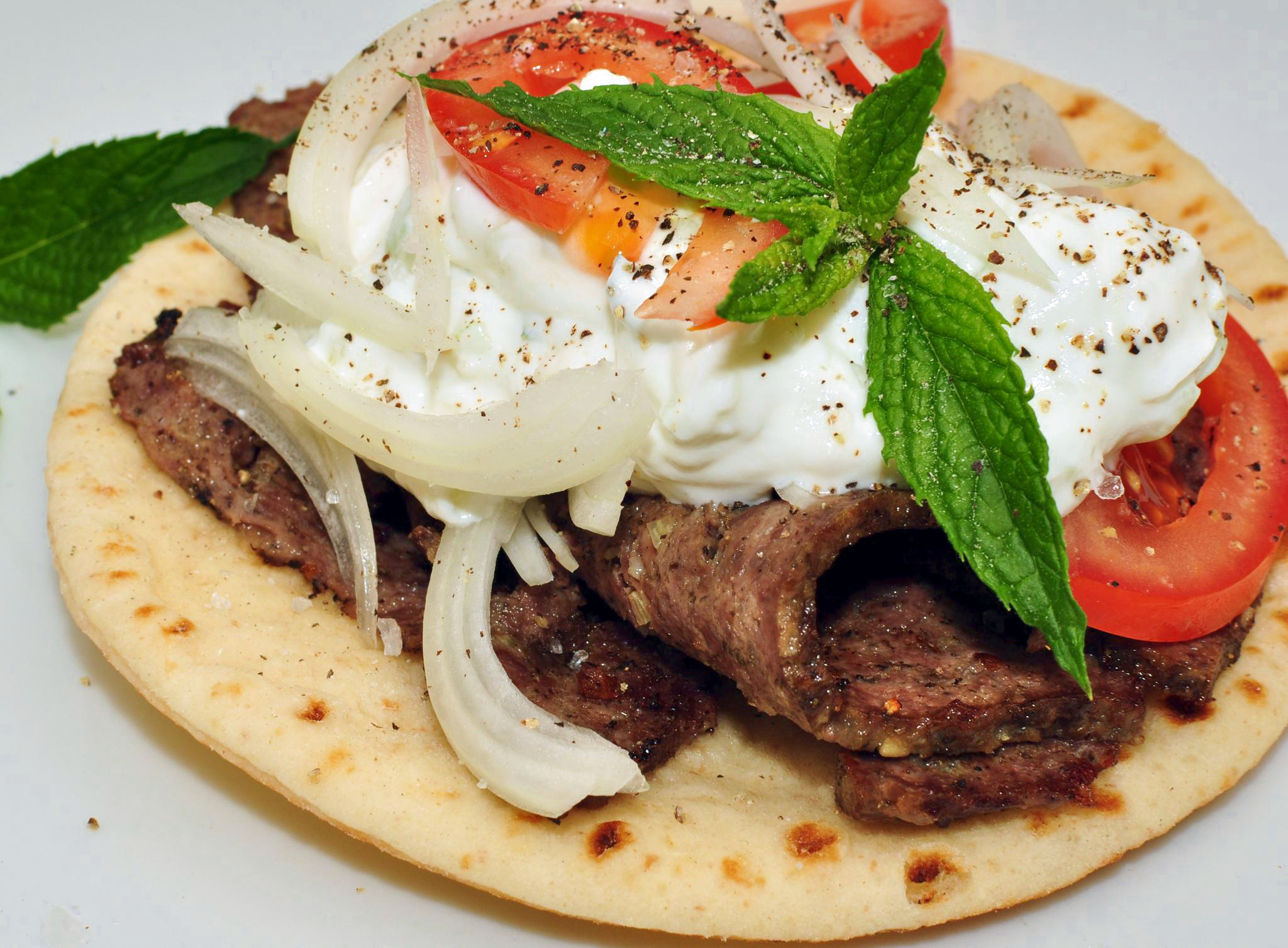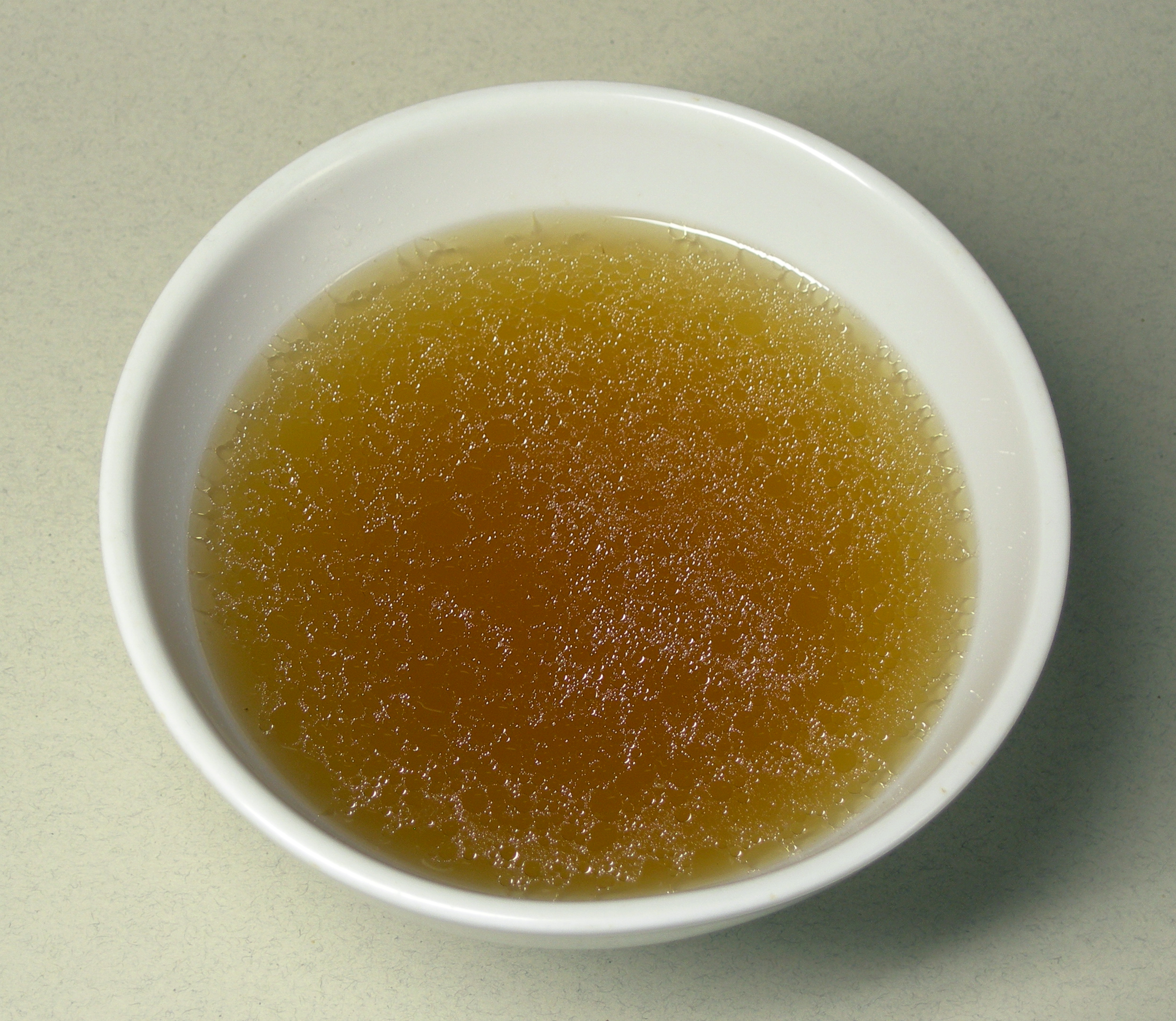|
Brunoise
Brunoise () is a culinary knife cut in which the food item is first julienned and then turned a quarter turn and diced, producing cubes of about or less on each side. In France, a "brunoise" cut is a smaller 1 to 2 mm. Some typical vegetables for a brunoise are carrots, celery, leeks, and turnips. The diced vegetables are blanched briefly in salty boiling water and then submerged in salted ice water for a few seconds to set the color. The brunoise is used as a garnish in many dishes; it is often used to garnish consommé In cooking, a consommé is a type of clear soup made from richly flavoured stock or broth that has been clarified, a process that uses egg whites to remove fat and sediment. Consommé has three English pronunciations: traditionally in the UK, t .... A brunoise should be consistent in size and shape, as this helps to create a pleasing and professional presentation. A brunoise cut is also used in stocks and soups to rapidly increase the rate that flavo ... [...More Info...] [...Related Items...] OR: [Wikipedia] [Google] [Baidu] |
List Of Culinary Knife Cuts
There are a number of regular knife cuts that are used in many recipes, each producing a standardized cut piece of food. The two basic shapes are the strip and the cube. Strip cuts * Pont-neuf; used for fried potatoes ("thick cut" or "steak cut" chips), pont-neuf measures from to * Batonnet; French for "little stick", the batonnet measures approximately . It is also the starting point for the small dice. * Julienne; referred to as the allumette (or matchstick) when used on potatoes, the julienne measures approximately . It is also the starting point for the brunoise cut. The first reference to Julienne occurs in François Massialot's Le Cuisinier Royal in 1722. * Fine julienne; measures approximately , and is the starting point for the fine brunoise cut. *Chiffonade; rolling leafy greens and slicing the roll in sections from 4-10mm in width Cube cuts Cuts with six even sides include: * Large dice; (or "Carré" meaning "square" in French); sides measuring approximately * M ... [...More Info...] [...Related Items...] OR: [Wikipedia] [Google] [Baidu] |
Julienning
Julienne, , or french cut, is a culinary knife cut in which the food item is cut into long thin strips, similar to matchsticks. Common items to be julienned are carrots for , celery for , potatoes for julienne fries, or cucumbers for . Trimming the ends of the vegetable and the edges to make four straight sides makes it easier to produce a uniform cut. A uniform size and shape ensures that each piece cooks evenly and at the same rate. The measurement for julienne is . Once julienned, turning the subject 90 degrees and dicing finely will produce brunoise (). The first known use of the term in print is in François Massialot's (1722 edition). The origin of the term is uncertain. A is composed of carrots, beets, leeks, celery, lettuce, sorrel, and chervil cut in strips a half- in thickness and about eight or ten in length. The onions are cut in half and sliced thinly to give curved sections, the lettuce and sorrel minced, in what a modern recipe would term . The root veget ... [...More Info...] [...Related Items...] OR: [Wikipedia] [Google] [Baidu] |
Dicing
Dicing is a culinary knife cut in which the food item is cut into small blocks or dice. This may be done for aesthetic reasons or to create uniformly sized pieces to ensure even cooking. Dicing allows for distribution of flavour and texture throughout the dish, as well as a somewhat quicker cooking time. Dicing usually applies to vegetables prepared in this way but it can also apply to the preparation of meat or fish and fruit. Brunoise is an especially small size, produced from further cutting of julienne-style food.Dice. CooksInfo.com. Published 11/24/2012. Updated 11/24/2012. Web. Retrieved 11/27/2012 from http://www.cooksinfo.com/dice See also * Russian salad Olivier salad ( rus, link=no, салат Оливье, salat Olivye) is a traditional salad dish in Russian cuisine, which is also popular in other post-Soviet countries and around the world. In different modern recipes, it is usually made with d ... and macédoine de légumes, foods based on cooked diced vegetable ... [...More Info...] [...Related Items...] OR: [Wikipedia] [Google] [Baidu] |
Carrot
The carrot ('' Daucus carota'' subsp. ''sativus'') is a root vegetable, typically orange in color, though purple, black, red, white, and yellow cultivars exist, all of which are domesticated forms of the wild carrot, ''Daucus carota'', native to Europe and Southwestern Asia. The plant probably originated in Persia and was originally cultivated for its leaves and seeds. The most commonly eaten part of the plant is the taproot, although the stems and leaves are also eaten. The domestic carrot has been selectively bred for its enlarged, more palatable, less woody-textured taproot. The carrot is a biennial plant in the umbellifer family, Apiaceae. At first, it grows a rosette of leaves while building up the enlarged taproot. Fast-growing cultivars mature within three months (90 days) of sowing the seed, while slower-maturing cultivars need a month longer (120 days). The roots contain high quantities of alpha- and beta-carotene, and are a good source of vitamin A, vitamin K, ... [...More Info...] [...Related Items...] OR: [Wikipedia] [Google] [Baidu] |
Celery
Celery (''Apium graveolens'') is a marshland plant in the family Apiaceae that has been cultivated as a vegetable since antiquity. Celery has a long fibrous stalk tapering into leaves. Depending on location and cultivar, either its stalks, leaves or hypocotyl are eaten and used in cooking. Celery seed powder is used as a spice. Description Celery leaves are pinnate to bipinnate with rhombic leaflets long and broad. The flowers are creamy-white, in diameter, and are produced in dense compound umbels. The seeds are broad ovoid to globose, long and wide. Modern cultivars have been selected for either solid petioles, leaf stalks, or a large hypocotyl. A celery stalk readily separates into "strings" which are bundles of angular collenchyma cells exterior to the vascular bundles. Wild celery, ''Apium graveolens'' var. ''graveolens'', grows to tall. Celery is a biennial plant that occurs around the globe. It produces flowers and seeds only during its second year. The first cul ... [...More Info...] [...Related Items...] OR: [Wikipedia] [Google] [Baidu] |
Leek
The leek is a vegetable, a cultivar of ''Allium ampeloprasum'', the broadleaf wild leek ( syn. ''Allium porrum''). The edible part of the plant is a bundle of leaf sheaths that is sometimes erroneously called a stem or stalk. The genus ''Allium'' also contains the onion, garlic, shallot, scallion, chive, and Chinese onion. Three closely related vegetables, elephant garlic, kurrat and Persian leek or ''tareh'', are also cultivars of ''A. ampeloprasum'', although different in their uses as food. Etymology Historically, many scientific names were used for leeks, but they are now all treated as cultivars of ''A. ampeloprasum''. The name ''leek'' developed from the Old English word , from which the modern English name for garlic also derives. means 'onion' in Old English and is a cognate with languages based on Old Norse; Danish ', Icelandic ', Norwegian ' and Swedish '. German uses ' for leek, but in Dutch, ' is used for the whole onion genus, Allium. Form Rather than for ... [...More Info...] [...Related Items...] OR: [Wikipedia] [Google] [Baidu] |
Turnips
The turnip or white turnip (''Brassica rapa'' subsp. ''rapa'') is a root vegetable commonly grown in temperate climates worldwide for its white, fleshy taproot. The word ''turnip'' is a compound of ''turn'' as in turned/rounded on a lathe and ''neep'', derived from Latin ''napus'', the word for the plant. Small, tender varieties are grown for human consumption, while larger varieties are grown as feed for livestock. In Northern England, Scotland, Ireland, Cornwall and parts of Canada (Quebec, Newfoundland, Manitoba and the Maritimes), the word ''turnip'' (or ''neep'') often refers to rutabaga, also known as ''swede'', a larger, yellow root vegetable in the same genus (''Brassica''). Description The most common type of turnip is mostly white-skinned apart from the upper , which protrude above the ground and are purple or red or greenish where the sun has hit. This above-ground part develops from stem tissue, but is fused with the root. The interior flesh is entirely white. The ... [...More Info...] [...Related Items...] OR: [Wikipedia] [Google] [Baidu] |
Blanching (cooking)
Blanching is a cooking process in which a food, usually a vegetable or fruit, is scalded in boiling water, removed after a brief, timed interval, and finally plunged into iced water or placed under cold running water (known as shocking or refreshing) to halt the cooking process. Blanching foods helps reduce quality loss over time. People often use blanching as a treatment prior to freezing, drying, or canning—heating vegetables or fruits to inactivate enzymes, modify texture, remove the peel, and wilt tissue. The inactivation of enzymes preserves color, flavor, and nutritional value. The process has three stages: preheating, blanching, and cooling. The most common blanching methods for vegetables/fruits are hot water and steam, while cooling is either done using cold water or cool air. Other benefits of blanching include removing pesticide residues and decreasing microbial load. Drawbacks to the blanching process can include leaching of water-soluble and heat sensitive nutrie ... [...More Info...] [...Related Items...] OR: [Wikipedia] [Google] [Baidu] |
Garnish (food)
A garnish is an item or substance used as a decoration or embellishment accompanying a prepared food dish or drink. In many cases, it may give added or contrasting flavor. Some garnishes are selected mainly to augment the visual impact of the plate, while others are selected specifically for the flavor they may impart. This is in contrast to a condiment, a prepared sauce added to another food item primarily for its flavor. A food item which is served with garnish may be described as being garni, the French term for "garnished." Many garnishes are not intended to be eaten, though for some it is fine to do so. Parsley is an example of a traditional garnish; this pungent green herb has small distinctly shaped leaves, firm stems, and is easy to trim into a garnish. Overview A garnish makes food or drink items more visually appealing. They may, for example, enhance their color, such as when paprika is sprinkled on a salmon salad. They may provide a color contrast, for example whe ... [...More Info...] [...Related Items...] OR: [Wikipedia] [Google] [Baidu] |
Consommé
In cooking, a consommé is a type of clear soup made from richly flavoured stock or broth that has been clarified, a process that uses egg whites to remove fat and sediment. Consommé has three English pronunciations: traditionally in the UK, the stress is on the middle syllable; in modern UK English, the stress is on the first; and in the US the stress is on the last. Cooking and serving A consommé is made by adding a mixture of ground meats, together with mirepoix (a combination of carrots, celery, and onion), tomatoes, and egg whites into either bouillon or stock. The key to making a high quality consommé is simmering; the act of simmering, combined with frequent stirring, brings impurities to the surface of the liquid, which are further drawn out due to the presence of acid from the tomatoes. Eventually, the solids begin to congeal at the surface of the liquid, forming a 'raft', which is caused by the proteins in the egg whites. Once the 'raft' begins to form, the heat is ... [...More Info...] [...Related Items...] OR: [Wikipedia] [Google] [Baidu] |
Cutting Techniques (cooking)
Cutting is the separation or opening of a physical object, into two or more portions, through the application of an acutely directed force. Implements commonly used for cutting are the knife and saw, or in medicine and science the scalpel and microtome. However, any sufficiently sharp object is capable of cutting if it has a hardness sufficiently larger than the object being cut, and if it is applied with sufficient force. Even liquids can be used to cut things when applied with sufficient force (see water jet cutter). Cutting is a compressive and shearing phenomenon, and occurs only when the total stress generated by the cutting implement exceeds the ultimate strength of the material of the object being cut. The simplest applicable equation is: \text = or \tau=\frac The stress generated by a cutting implement is directly proportional to the force with which it is applied, and inversely proportional to the area of contact. Hence, the smaller the area (i.e., the sharper th ... [...More Info...] [...Related Items...] OR: [Wikipedia] [Google] [Baidu] |



.jpg)


.jpg)



